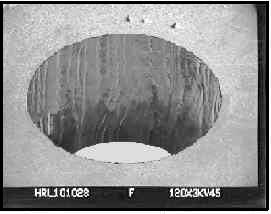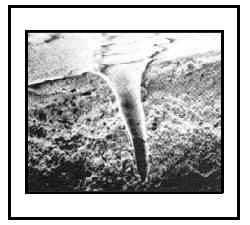Laser Drilling and Machining of Ceramic Substrates
APPLICABILITY
This document provides general guidelines and considerations for the laser drilling and machining of fired ceramic substrates typically used in the manufacture of microelectronic circuits and multichip modules. The specifications and tolerances given here will generally produce the MOST COST EFFECTIVE design approach. Tighter tolerances may be achieved at some increased cost and leadtime.
PURPOSE OF LASER DRILLING AND MACHINING
The CO2 laser has become an important tool in the precision fabrication of technical ceramics. The reasons for this are in the technological changes that have occurred within the electronic industry to miniaturize parts and produce them using batch fabrication methods.
A brief history:
In the early days of ceramic substrate fabrication, individual substrates where small in overall size, relatively thick, and substrate features were generally large. These small parts were typically metalized one-at-a-time using automated feeders and loaders. The state of the art in substrate tolerances was +/- 1%.
Early fabrication methods in fired ceramic involved machining substrate features with carbide, diamond or ultrasonic tools. Although these techniques were not really cost effective and were limited in the type and size of features they could create, there were all that was available at the time when precision locations of features were required.
A subsequent method was developed that utilized precision tooling to punch the required features in “green” ceramics before firing. This method improved the cost situation when the quantities produced justified the cost of prototyping and tooling. Tolerances improved but were limited by variations in the firing process. Green punching technology can be quite effective for volume production runs where substrate features are relatively large and the lot-to-lot and part-to-part tolerances are +/- 1% or larger. Feature size is generally limited to holes or shapes greater than 0.010 in. across the smallest dimension.
In recent years the high circuit densities and cost reduction efforts demanded by the electronic industry have required that batch fabrication methods be used to cost effectively manufacture ever shrinking miniature substrates. As a result, new hardware, tooling, and techniques have been developed to fabricate multiple parts with high precision on large substrate sheets.
As a result, the CO2 laser has developed into the most precise and versatile method of fabricating ceramic substrates. Under software control the laser can create features of virtually any planar shape and can maintain tolerances to within +/-0.001 in. The laser is extremely flexible and permits close location of features with considerable layout flexibility. Hard tooling is not required, turnaround is quick, and the cost is low.
The combination of green punching and laser machining can be cost effective for manufacturing substrates with large, non-critical holes and small, high density features requiring precision.
TYPES OF CERAMIC MATERIALS
Materials covered include thin, flat substrates of Alumina, Aluminum Nitride. Call the Accu-Tech facility directly for technical information on other special materials that may be laser machined.
GENERAL MATERIAL CHARACTERISTICS
Alumina, 96%
Excellent overall substrate material for cost effective manufacturing and laser processing. Typically represents over 90% of the microelectronics volume.
Alumina, 99+%
Similar to 96%. Provides a superior surface for fabricating Thin Film circuitry.
ALUMINUM NITRIDE
Roughly equivalent in heat conductivity to Beryllia but the safety issue is avoided. Call Accu-Tech for additional information on this material.
SUBSTRATE SIZE AND LIMITS
Typical Substrate Size: 4.5” X 4.5” – Larger sizes can be processed.
Typical Substrate Thickness: 0.010 in. TO 0.060 in. – Thickness greater than 0.100 can be processed.
COST EFFECTIVE DRILLING OF HOLES
In order to achieve cost effective manufacturing, multiple parts are typically created on a single large substrate. The parts are then processed in batch form and later singulated into individual substrates by breaking along scribe lines. The processing of either individual substrates or arrays requires accurate registration at each operation.
SUBSTRATE ALIGNMENT OPTIONS
Several options for alignment of laser produced features to the substrate edges are listed below in order of increasing laser processing cost.
1. SCRIBED OUTSIDE EDGES – After scribing the substrate, the borders are broken off to produce accurate outside reference edges for the subsequent processing operations.
2. AS-FIRED OUTSIDE EDGES – The pattern to be cut by the laser is located on the substrate in relation to the original edges. Two adjacent edges on the substrate are used to form a reference corner. The entire substrate can be utilized with this method but the alignment accuracy may be poor due to irregularities in the fired edges.
3. ALIGNMENT FLATS – The alignment repeatability can be improved for subsequent processing by the addition of precision, laser machined flats along the outside reference edges of the substrate. These flats provide a smooth surface to make accurate contact with the tooling pins. Using this method avoids the expense of laser machining the entire substrate edge.
4. POST ALIGNMENT – With this method, cut features can be optically aligned to the substrate metalization or other surface features such as holes, edges or other existing scribe lines. Accuracy is excellent.


